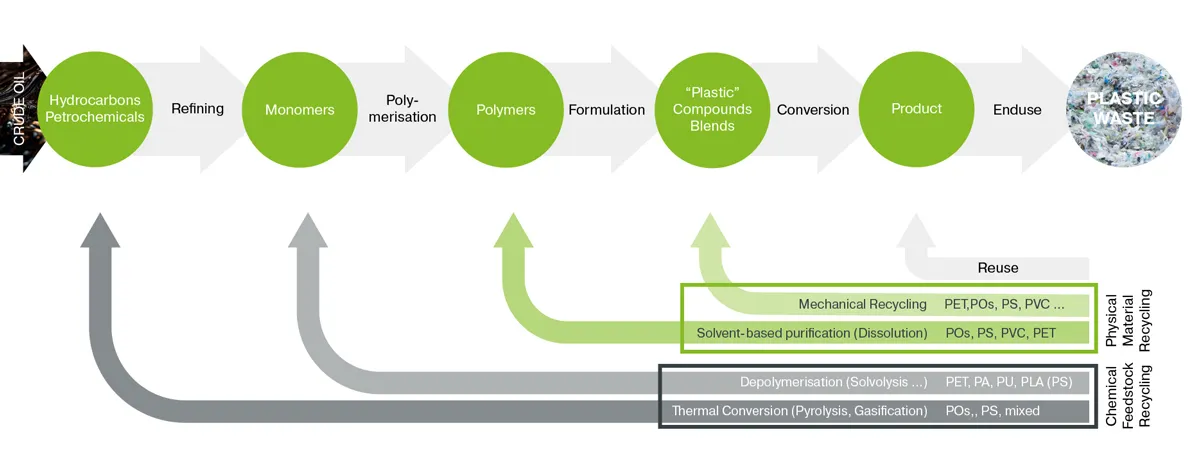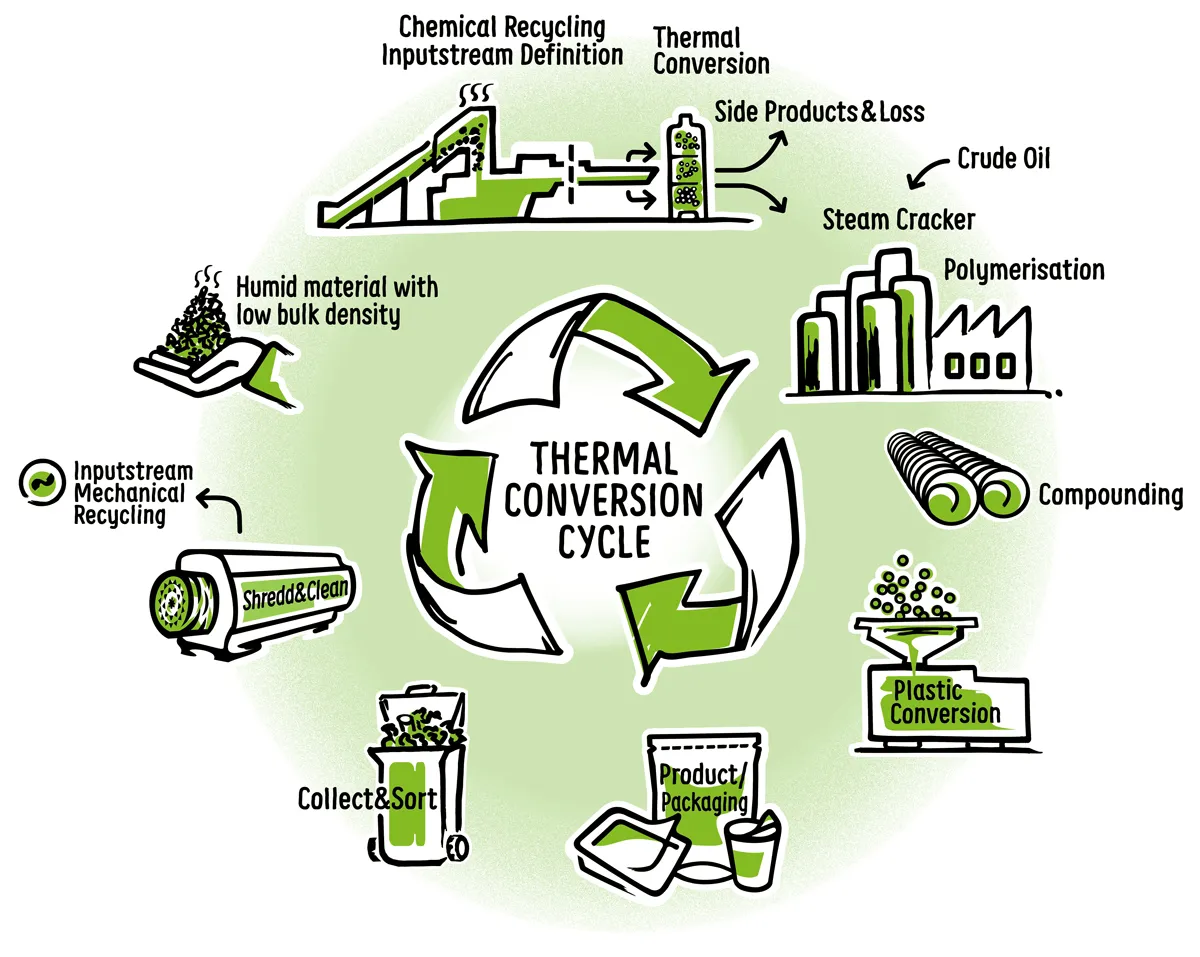Chemical plastic recycling
It is well known that irresponsible use of plastic waste is a problem for the environment. It is estimated that by 2030, global plastic consumption will reach 460 million tons.
To create an effective circular economy, these materials must be recycled. When people talk about recycling, they often mean mechanical processes. But this is not the only way to process such materials. Chemical plastic recycling is also a possibility.
In this blog post, we take a closer look at chemical processes.

What is chemical plastic recycling?
Compared to mechanical recycling, chemical plastic recycling changes the chemical structure. The Polymers are broken down into their original components — monomers, and hydrocarbons.
The European coalition describes chemical plastic recycling as follows: Polymeric waste is converted into new substances through chemical change. These are used as products or raw materials for manufacturing products. The following diagram describes the production of plastics and the ways of reusing and recycling them.
- The diagram below shows the production of plastics from crude oil and the use and generation of plastic waste.
- The colored arrows below the process show the recycling methods.

The grey “Re-use” arrow refers to reusing the products without processing them. The light green arrow below it refers to mechanical recycling.
Chemical plastic recycling is often divided into three main groups — these are the bottom three arrows in the diagram:
- Solvent-based recycling
Although this processing method does not change the chemical composition of the materials, chemical substances are used in the process. Solvent-based recycling, which is actually a physical process, is often mistakenly grouped together with chemical plastic recycling processes. - Depolymerization
Materials such as PET, PA, PU or PLA are returned to their monomers. New polymers can be produced from this. The advantage of this form of processing is that new material can be produced. However, it requires significantly greater plant complexity and higher energy consumption. - Thermal conversion (pyrolysis)
The most common technique on the chemical recycling market (70-80 %) is pyrolysis. This method is used for polyolefins such as polyethylene and polypropylene. This means it can treat most PE and PP plastics.
During pyrolysis, the plastics are returned to synthetic crude oil. The process takes place at 350-700 °C in an oxygen-free (inert) environment. Long polymer chains are broken down into shorter ones. To convert at least some of the synthetic crude oil into plastics, the entire petrochemical production chain must be repeated.
This makes it possible to use plastics to obtain new petrochemical products such as fuels, basic chemicals, or naphtha for the production of monomers in a steam cracker, for example. Depending on the quality of the materials and petrochemical process chains, the achievable yields for new plastics are between 15 % and 50 %. The recycling grades that can actually be achieved from chemical recycling and could be included in the quotas are not yet regulated by law in Europe. An appropriate definition for a mass balance approach is in preparation and the subject of highly controversial discussions. The mass balance model allows recycled content to be allocated mathematically, even if the final product does not entirely consist of recycled material. Critics warn that this could mislead consumers and undermine trust in recycling processes.
Differences between mechanical and chemical plastic recycling
Mechanical recycling turns plastics into pellets. This method requires little energy and low investment and enables significant carbon footprint reductions. Contrary to widespread opinion, high-quality end products, even including food-grade packaging, are possible with mechanical recycling. Chemical plastic recycling is different. In it, reactors with high temperatures and catalysts are used. It should be used when mechanical recycling reaches its limits. However, chemical processes require more energy and generate greenhouse gas emissions.
Mechanical processes also prepare materials for chemical plastic recycling. Pyrolysis is used for waste from the yellow bag, such as PP and PE packaging, in particular. Before chemical plastic recycling, it must first be prepared using mechanical processes, however. Ideally, both methods complement each other rather than compete with each other. But this only occurs when materials suitable for the more efficient mechanical recycling are processed in this way and chemical recycling takes on new material flows that could not previously be recycled.
Despite this, mechanical recycling is often criticized. The objection raised is that the polymer chains become ever shorter because of repeated processing, resulting in low-quality products. Chemical recycling promises the prospect of manufacturing higher-quality products, in particular food packaging.
However, chemical plastic recycling has the disadvantage that during pyrolysis, for example, only a relatively small proportion of the plastic can be processed back into plastics. It is often presented as a “perfect cycle,” which is not quite true.
A misconception that has now been dispelled was that chemical recycling can produce new plastics even from the lowest-quality input. This is, of course, not the case; good-quality input material is also essential for successful chemical recycling.

Mechanical recycling technologies for preparing material for chemical plastic recycling
Chemical plastic recycling is not all that different from mechanical recycling in that it too requires well-defined and prepared material input flows. For both types of recycling, careful sorting of mixed plastics is indispensable. Mechanical cleaning processes (dry or wet cleaning) are used here. A decisive factor in this is the properties of post-consumer plastics (low bulk density, contamination, moisture) which are difficult to deal with.
In pyrolysis especially, extrusion is used to heat input materials to temperatures of up to 300 °C quickly and energy-efficiently. At the same time, atmospheric oxygen is removed from the material as well as moisture.
The CHEMAREMA® series combines various technologies from the EREMA Group with the aim of preparing input materials for chemical recycling as efficiently as possible. Also by using this technology there is no additional pre-agglomeration step necessary which saves ~40% of energy.
Mechanical vs. chemical plastic recycling at a glance
| Mechanical recycling | Chemical plastic recycling | |
| Process | Plastic is processed to pellets |
|
| Energy requirement | Low | High |
| Investment requirement | Low | High |
| Equipment | Extruder | Reactors, catalysts, possibly extruders too |
| Material preparation | Sorting and washing | Sorting, rough cleaning, washing if necessary |
| Area of application | Especially for pure and clean plastics | Ideally, takes over from mechanical recycling where this reaches its limits |
| Examples of materials | Thermoplastics (PET, PE, PP, PS, PA, PC...) | e.g. PP and PE using pyrolysis and PET, PA using depolymerization |
| Disadvantages | Plastic chains get shorter due to repeated recycling | Only a relatively small proportion is converted back to plastics, which requires a lot of energy |
| Advantages | Efficient and less costly | Can produce high-quality new material, also for food packaging |
What are the limitations of chemical plastic recycling?
Like mechanical recycling, chemical plastic recycling also has its limits. Even with chemical recycling, low-quality materials cannot be converted into high-quality products. Like mechanical recycling, methods such as pyrolysis require relatively narrowly defined material flows, even though the acceptance of mixed fractions is somewhat higher. For example, pyrolysis can only process polyolefins and possibly polystyrenes. Using other materials leads to issues. PET contains oxygen in its chemical structure, which would be released during pyrolysis. Since pyrolysis occurs in the absence of oxygen, processing PET is unsuitable. When polyamide is processed, nitrogen is released. If nitrogen enters the reactor, hazardous compounds are formed. PVC contains dangerous chlorine. Therefore, the material streams are limited to just two types of materials: polyolefins and polystyrenes.
The chemical depolymerization of polyesters would also theoretically be capable of processing highly contaminated material flows (such as post-consumer textiles). However, in practice, this involves enormous technological effort. In the end, economic efficiency is only achieved if earnings are high. This requires careful sorting, preparation, and purification of input flows. The situation is similar with solvent-based recycling.
What is the impact of PPWR on chemical plastic recycling?
The PPWR (Plastics Packaging Waste Regulation) will have a significant impact on the recycling industry. From 2030 and 2040, contact-sensitive plastics will be more closely regulated and subject to minimum grades of recycled material. For the chemical recycling industry this is a potential boost, depending on whether, and to what extent, the proportion of recycled material from chemical plastic recycling is recognized in the future.
To date, chemical processing is yet to be recognized as true recycling. There is currently a lack of relevant legislation and definitions for this.
Chemical plastic recycling: the key to a circular economy?
Chemical plastic recycling can complement mechanical recycling, particularly for plastics that are difficult to recycle. While mechanical recycling is cost-effective and energy efficient, it has its limitations when it comes to contaminated materials.
Chemical processing can score points here by breaking down polymers into their basic building blocks. Nevertheless, current technologies face significant challenges:
- High energy consumption and emissions
- Unclear regulatory frameworks for recognizing recycling rates
- Lack of economic viability and limited recycling rates
To truly contribute to a circular economy, chemical recycling must be further developed—with clear standards, greater transparency, and improved environmental performance. Until then, mechanical recycling remains the most efficient and sustainable solution for many plastics.